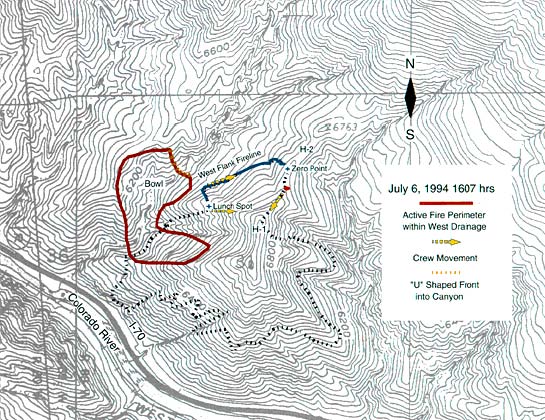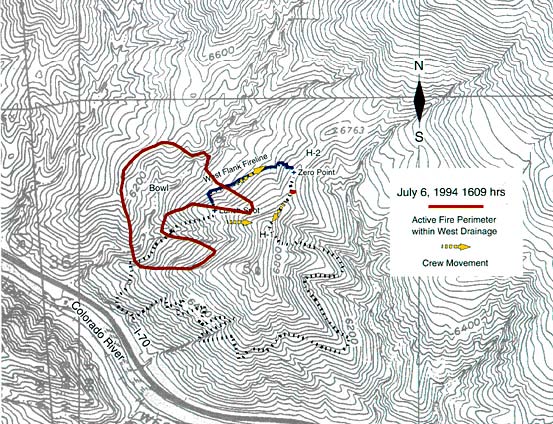
 South
Canyon Fire South
Canyon Fire
1994
6 Minutes for Safety — 2009
Fire Behavior Report, 1998
Fire Environment
- July 2 to
Evening of July 5
- July
5, 2230 to July 6, 1530
- July 6, 1530
to 1600
- July 6, 1600
to 1603
- July
6, 1603 to 1609
- July 6, 1609
to 1610
- July 6, 1610
to 1611
- July 6, 1611
to 1614
- July 6, 1614
to 1623
- July
6, 1622 to 1830
- July
6, 1830 to July 11
References
Appendix A
Appendix B
Appendix C
|
 Fire
Behavior Associated with the 1994 South Canyon Fire on Storm King Mountain,
Colorado Fire
Behavior Associated with the 1994 South Canyon Fire on Storm King Mountain,
Colorado
Fire Chronology (continued)
July 6, 1609 to 1610—Fire on West Flank
Smokejumper Mackey caught the firefighters hiking up the West Flank Fireline
as they passed the Stump (about 1609). Using known values for walking
speeds in rough terrain and distances along the fireline, we estimate
that Mackey must have run to catch the last of the hotshots at this location.
By this time the smokejumpers and hotshots were hiking in essentially
one group, hereafter referred to as the West Flank Fireline Group. The
group continued to follow the West Flank Fireline. They hiked over the
Spur Ridge and then east up the fireline toward the Main Ridge.
West Flank Fireline—The fire moved onto the West
Bench. It rapidly increased in size, burning across a wide front. It was
spreading north up the West Drainage and upslope on a path parallel to
the Lunch Spot Ridge (approximately 1608).
As Smokejumper Hipke reached the top of the Spur Ridge he looked back
and saw Mackey at the rear of the group (approximately 1609) (Hipke 1995).
Behind Mackey the fire burned in a wide front above and below the West
Flank Fireline (fig. 27). Hipke states that due to the height of the Gambel
oak and the drainage topography, the firefighters had only brief glimpses
of the fire burning behind and below them.

Figure 26—Fire perimeter at 1607 as Smokejumper Hipke looked down
canyon (southwest) from the Stump. Fire was burning on both sides of the
West Drainage and below the West Flank Fireline.
The Tree—Firefighters Haugh and Erickson at the
Tree could hear a loud roaring sound from the fire. They saw the first
few smokejumpers in the group cresting the Spur Ridge and walking northeast
along the West Flank Fireline toward them. They saw fire burning behind
and below the West Flank Fireline Group. Erickson called Mackey and told
him about the fire, Mackey did not respond (time, about 1610).
Main Ridge—The firefighters hiking along the Main
Ridge neared the rocky outcropping north of H-1. They saw fire nearly
all the way up the slope below and to the west of them (estimated time
1609). Several firefighters near the front of the group felt they could
not make it to the safety zone at H-1 before the fire reached the top
of the ridge. This was the same fire run Hipke saw from the Spur Ridge.
The terrain was steep, the firefighters were fatigued, and spot fires
on the Main Ridge between them and H-1 were actively burning (South Canyon
Report; OSHA 1995). Hotshot Scholz told the Prineville firefighters to
“Reverse and move”—meaning to return the way they had
come (Scholz 1995). BLM Squad Boss Ryerson also told her crew to go to
H-2. Both crews turned back and began walking and running north down the
Main Ridge toward H-2.

Figure 27—Fire perimeter at 1609 as Smokejumper Hipke looked south
from point where fireline crested the Spur Ridge. The fire had crossed
the southern portion of the West Flank Fireline. It was burning up the
West Flank Fireline, north up the West Bench, and east to the Main Ridge.
Hipke estimates that at this time the fire burning east up the slope was
about two-thirds of the distance up the slope below H-1.
Hotshot Crewmember Navarro, intending to maintain his place near the
end of the line, let others pass him. As he was looking south toward H-1
he saw Hotshots Valentine and Robertson. It appeared as if “they
came running right out of the fire” (South Canyon Report; OSHA 1995).
The two firefighters ran through fire, but it consisted of scattered,
relatively short flames along the Main Ridge Fireline. The fires burning
along the top of the Main Ridge behind (south of) the firefighters were
several times taller than a person and burning on both sides of the Main
Ridge Fireline. These larger flames were caused by the main fire cresting
the ridge between the Rocks and H-1.
<<< continue
reading—Fire Behavior at South Canyon Fire, Fire
Chronology: July 6, 1610 >>>
|
